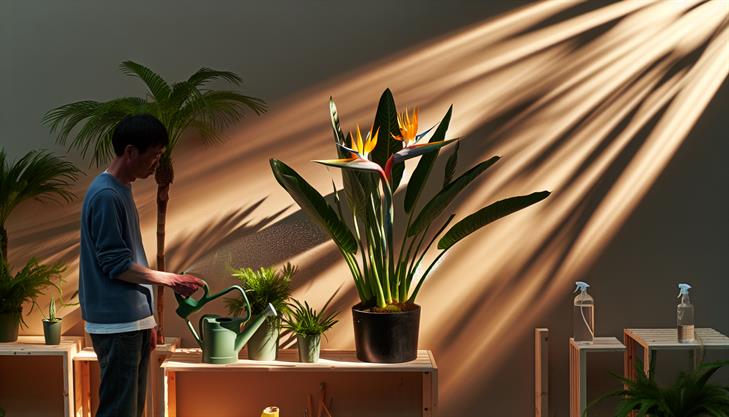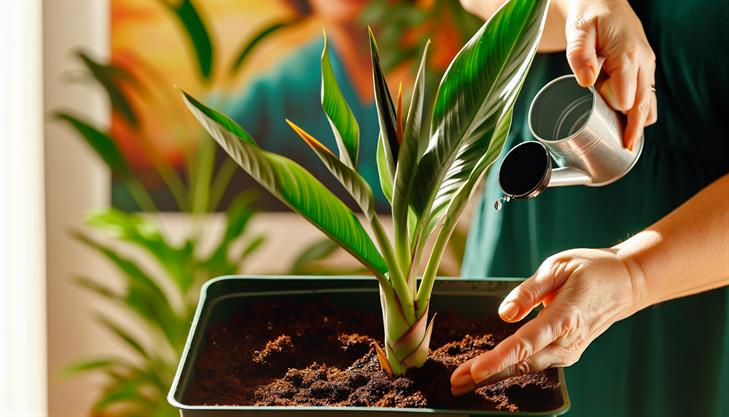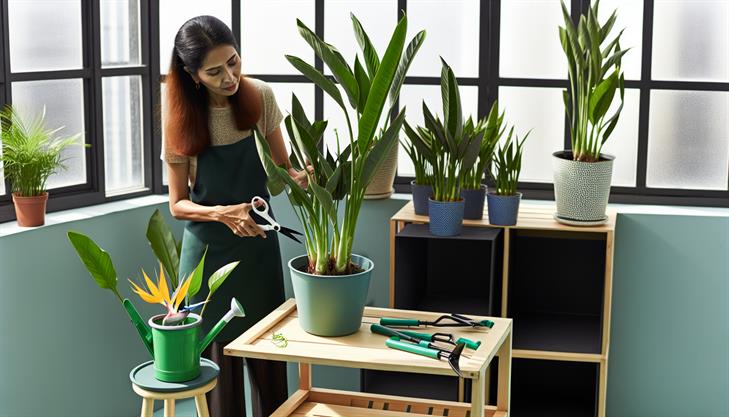The Bird of Paradise plant, with its stunning, exotic blooms and vibrant foliage, is one of the most coveted houseplants for adding a touch of paradise to any home. Resembling a tropical bird in mid-flight, this striking plant instantly elevates any room into a luxurious escape. However, as with any piece of paradise, keeping this beauty thriving requires attentive care. Whether you’re a seasoned plant enthusiast or a budding botanist, understanding the specific needs of the Bird of Paradise can keep your plant flourishing for years to come. This guide delves into the essentials of Bird of Paradise care, offering expert tips and tricks to nurture these botanical masterpieces. Discover how to unlock the secrets to their lush growth and magnificent flowering right here, and bring a slice of paradise into your own living space.
Understanding the Bird of Paradise Plant’s Needs
The Bird of Paradise plant, known for its striking, exotic flowers and lush foliage, is a popular choice for plant enthusiasts looking to add a tropical touch to their homes or gardens. To keep this vibrant plant thriving, it’s essential to understand its specific needs and provide proper care. Here’s a step-by-step guide on how to care for a Bird of Paradise plant:
Light Requirements
The Bird of Paradise plant prefers bright, indirect sunlight. Ideally, position it in a spot where it can receive at least 4-6 hours of light daily. Outdoor plants should be situated in a partially shaded area to prevent the leaves from getting scorched by intense sunlight. If you’re growing it indoors and lack natural light, consider using a grow light to supplement its lighting needs.
Watering Schedule
Watering is crucial for the health of your Bird of Paradise plant. During the growing season (spring and summer), the plant prefers consistently moist soil but not soggy. Water your plant when the top inch of the soil feels dry. In the fall and winter, reduce watering as the plant’s growth slows. Overwatering can lead to root rot, a common issue with this plant, so ensure there’s adequate drainage to prevent water from pooling at the bottom of the pot.
Soil and Potting
A well-draining potting mix is essential for a Bird of Paradise plant. Use a regular potting soil mixed with sand or perlite to improve drainage. As the plant grows, repot it every 2-3 years to prevent it from becoming root-bound, which can stunt growth. Choose a pot that is only a few inches larger than the current one each time you repot.
Temperature and Humidity
Bird of Paradise plants thrive in warm environments. Keep indoor temperatures between 65°F and 70°F (18°C – 21°C) for optimal growth. High humidity levels are also preferable, so consider misting the leaves regularly or placing a humidifier nearby. Avoid placing the plant near drafts or sudden temperature changes, which can stress it.
Fertilization
During the growing season, feed your Bird of Paradise plant with a balanced liquid fertilizer every two weeks. This helps boost growth and encourages flowering. In the dormant months (fall and winter), reduce fertilization to once a month or stop altogether to give the plant rest.
Pruning and Maintenance
Regular pruning helps maintain the plant’s appearance and encourages new growth. Remove any yellowing or dead leaves by cutting them off at the base with clean, sharp scissors or pruning shears. Additionally, wipe the leaves occasionally with a damp cloth to remove dust and keep the plant looking healthy.
Common Issues and Troubleshooting
Pests: Keep an eye out for common pests like spider mites and mealybugs. If detected, treat them promptly with insecticidal soap or neem oil.
Leaves Curling or Browning: This can result from inadequate watering or exposure to drafty conditions. Adjust your watering schedule and relocate the plant if necessary.
Failure to Bloom: If your Bird of Paradise isn’t blooming, it might not be getting enough light or could be suffering from nutrient deficiencies. Evaluate your care routine to ensure all its needs are being met.
By understanding and addressing these requirements, you can ensure your Bird of Paradise plant remains healthy and vibrant. With proper care, this plant can live for many years, providing natural beauty and a touch of the tropics to any space.
Watering and Soil Requirements for Optimal Growth
To ensure your Bird of Paradise plant thrives and shows off its striking tropical foliage and blooms, it’s crucial to meet its watering and soil requirements accurately. Understanding these basic needs will set the stage for optimal growth and a healthier plant. Here’s a guide on how to care for your Bird of Paradise plant effectively:
Watering Requirements:
-
Regular Watering: During the growing season, typically spring and summer, aim to water your Bird of Paradise plant once a week. Ensure the top inch of soil dries out between waterings to prevent root rot, which can occur if the soil is consistently water-logged.
-
Reduce in Fall and Winter: As the plant’s growth slows, reduce watering frequency. Monitor the soil for dryness before deciding to water, generally every 2-3 weeks.
-
Adequate Drainage: Proper drainage is critical. Use pots with ample drainage holes, and consider adding a layer of gravel at the bottom of the pot to enhance drainage.
-
Water Quality: Use filtered or rainwater if possible, as Bird of Paradise plants can be sensitive to salt and mineral build-up found in tap water.
Soil Requirements:
-
Soil Mixture: Bird of Paradise prefers well-draining, nutrient-rich soil. A mix of one part perlite, one part potting soil, and one part peat moss or coco coir works well, offering both drainage and moisture retention.
-
pH Balance: Aim for a slightly acidic to neutral pH (around 5.5 to 7.0). Periodically testing your soil’s pH can be helpful to maintain this balance.
-
Organic Matter: Incorporating organic matter such as aged compost can boost soil fertility, promoting vigorous growth.
Practical Tips:
-
Humidity: Native to tropical climates, Bird of Paradise plants enjoy higher humidity levels. Mist your plant occasionally or place a humidifier nearby, especially during dry months.
-
Sunlight Exposure: Place your plant in a well-lit area where it can receive at least 4-6 hours of direct sunlight daily. Insufficient light can lead to fewer blooms.
-
Fertilization: During the growing season, apply a balanced, water-soluble fertilizer every 2-4 weeks to nourish the plant. Reduce feeding during the dormant period.
Common Issues:
-
Yellowing Leaves: This could signal overwatering. Check the soil’s moisture level and drainage setup.
-
Brown Leaf Tips: Often a sign of low humidity or high mineral content in water. Ensure appropriate watering practices and maintain adequate indoor humidity.
-
Pest Problems: Mealybugs and spider mites can occasionally infest Bird of Paradise plants. Regularly inspect your plant and treat infestations with insecticidal soap or neem oil.
Additional Advice:
-
Repotting: Every 1-2 years, or when the plant outgrows its pot, refresh the soil and consider moving to a larger pot.
-
Pruning: Trim dead leaves and spent flowers to encourage new growth and maintain the plant’s shape.
By following these guidelines on how to care for a Bird of Paradise plant, you can enjoy a vibrant and enduring display of its magnificent leaves and flowers. Adjust your care routine as per seasonal changes and individual plant responses for best results.
Light and Temperature Tips for a Healthy Plant
Caring for a Bird of Paradise plant requires attention to light, temperature, and general maintenance to ensure it thrives and blooms beautifully. Follow these comprehensive guidelines to keep your plant healthy:
Light Requirements
The Bird of Paradise (Strelitzia) demands bright, indirect light to flourish. Here’s how to manage its light requirements:
-
Placement: Position your plant near a window that receives plenty of sunlight but is shielded from direct rays, which can scorch its leaves. An east-facing window is ideal. If outdoor space is available, a location with filtered sunlight or partial shade works well.
-
Light Adjustment: If your plant shows signs of insufficient light, such as slow growth or leaves failing to open, consider using grow lights to supplement. Conversely, if leaf edges turn brown, reduce exposure to direct sunlight.
Temperature Preferences
Temperature plays a crucial role in how to care for a Bird of Paradise plant:
-
Optimal Range: Maintain a temperature between 65°F and 85°F (18°C to 29°C). This warmth mimics its native subtropical environment.
-
Temperature Fluctuation: Protect the plant from cold drafts and sudden temperature changes, which it dislikes. During colder months, bring your plant indoors if temperatures fall below 60°F (15°C) to prevent damage.
Additional Care Tips
-
Watering: Water your Bird of Paradise when the top inch of soil is dry. In the active growing period of spring and summer, this might mean watering weekly. Reduce frequency in the winter months. Ensure the pot has proper drainage to prevent root rot.
-
Humidity: These plants appreciate higher humidity. Increase humidity by misting the leaves regularly, placing the pot on a humidity tray, or using a humidifier if the air in your home is particularly dry.
-
Fertilization: During the growing season, from spring to early autumn, feed your Bird of Paradise every month with a balanced, water-soluble fertilizer to encourage growth and flowering.
-
Pruning and Cleaning: Remove old or damaged leaves to promote new growth. Wipe down the leaves regularly with a damp cloth to avoid dust buildup, which can impact photosynthesis.
-
Repotting: Every couple of years or when the plant becomes root-bound, repot your Bird of Paradise into a slightly larger pot to provide space for growth. Use well-draining potting soil to enhance aeration around the roots.
Common Issues
- Yellowing Leaves: Often an indicator of overwatering. Evaluate your watering schedule and soil drainage.
- No Blooms: Lack of blooms may indicate insufficient light. Increase exposure to bright, indirect sunlight and ensure adequate fertilization during the growing season.
- Pest Infestation: Watch out for pests like spider mites and mealybugs. Treat infestations promptly with insecticidal soap or neem oil.
By following these step-by-step instructions on how to care for your Bird of Paradise plant, you’ll ensure it grows vigorously and adds a tropical ambiance to your home or garden. Keeping an eye on light, temperature, and general maintenance will help prevent common issues and support its overall health.
Pruning and Maintenance: Keeping Your Plant Looking Great
Caring for a Bird of Paradise plant can be a rewarding experience, as these striking tropical plants bring a taste of paradise into your home or garden. Known for their vibrant blooms and lush foliage, Bird of Paradise plants require specific care to thrive. By following these detailed instructions, you’ll be able to ensure your plant remains healthy and visually appealing.
Location and Light Requirements
To successfully care for a Bird of Paradise plant, first consider where you place it. These plants thrive in bright, indirect sunlight. If indoors, choose a space near a large window where they can soak up the morning sun. If outdoors, find a location that receives partial sunlight. Too much direct sun can scorch the leaves, while not enough light may hinder the plant’s growth and bloom production.
Watering Practices
Proper watering is crucial in caring for a Bird of Paradise. Always check the moisture level of the soil before watering. In the growing season (spring and summer), water the plant when the top inch of soil feels dry, ensuring the water fully saturates the root zone. During the dormant period (fall and winter), reduce watering frequency, allowing the soil to partially dry out between waterings. Be cautious of overwatering, as this can lead to root rot—a common issue with these plants.
Soil and Potting Tips
The Bird of Paradise prefers well-draining soil to prevent waterlogged roots. A mixture of potting soil, sand, and peat moss can provide optimal drainage and aeration. If planting in a pot, select one with drainage holes to prevent excess water accumulation. Repotting every two to three years or when the plant outgrows its container can help maintain healthy growth.
Fertilization and Feeding
To keep your Bird of Paradise plant looking its best, regular feeding during the growing season is important. Use a balanced, slow-release fertilizer every two weeks from spring through early fall to promote vigorous growth and blooming. Be mindful not to over-fertilize as this may lead to salt buildup, damaging the plant’s root system.
Pruning and Maintenance
Pruning is a key aspect of Bird of Paradise plant care. Regularly remove any dead or yellowing leaves by cutting them at the base using clean, sharp scissors or pruning shears. This not only keeps your plant looking tidy but also encourages new growth. If your plant becomes too large, aesthetic shaping can be done by cutting back stems to the desired size.
Common Issues and Solutions
Despite best efforts, you may encounter problems such as pests and diseases. Spider mites, aphids, and mealybugs are common pests that can infest the Bird of Paradise. Treat these with insecticidal soap or neem oil. For fungal diseases caused by overwatering, ensure proper drainage and air circulation around the plant.
Additional Tips
- Humidity: Bird of Paradise plants prefer a humid environment. If your home has low humidity, consider using a humidifier or placing a tray of water near the plant to increase moisture levels.
- Temperature: They thrive in temperatures between 65°F to 70°F (18°C to 21°C). Protect the plant from cold drafts or sudden temperature drops.
By following these steps and providing the care needed for a Bird of Paradise plant, you’ll cultivate a tropical masterpiece that not only enhances your living space but also rewards you with its exotic beauty.
Troubleshooting Common Bird of Paradise Plant Problems
The Bird of Paradise plant (Strelitzia reginae), with its stunning, bird-like flowers, is a popular choice for plant enthusiasts wanting to introduce a tropical flair to their homes or gardens. To ensure your Bird of Paradise thrives, follow these care tips, troubleshoot common problems, and create the perfect environment for your plant.
Choosing the Right Spot
The Bird of Paradise requires plenty of light to produce its vibrant flowers. Opt for a bright, sunny spot that receives at least 4-6 hours of direct and indirect sunlight daily. If you’re growing it indoors, a south or west-facing window is ideal. Too little light can stunt the plant’s growth and reduce flowering, while excessive direct sunlight can scorch the leaves.
Soil and Potting
Use a well-draining potting mix rich in organic material. A blend of potting soil, sand, and perlite or pumice is ideal. This mix ensures that the roots have good aeration and can retain just the right amount of moisture.
Watering Routine
Water your Bird of Paradise plant deeply but infrequently, allowing the top two inches of soil to dry out before watering again. Overwatering can lead to root rot, a common issue that can be avoided by ensuring proper drainage and not letting the plant sit in standing water.
Humidity and Temperature
This tropical plant thrives in humidity. If your home is dry, consider placing a humidifier nearby or misting the leaves periodically. The ideal temperature for the Bird of Paradise is between 65°F to 75°F (18°C to 24°C). Avoid exposure to temperatures below 50°F (10°C), which can damage the plant.
Fertilization Needs
Feed your Bird of Paradise a balanced, water-soluble fertilizer every two weeks during the growing season (spring and summer). Reduce the feeding frequency to once a month in fall and winter when the plant’s growth slows.
Pruning and Maintenance
Remove any dead or yellowing leaves to keep the plant looking its best and to encourage new growth. If the plant becomes too large, you can also trim it back safely to maintain its desired shape and size.
Common Problems and Solutions
- Yellowing Leaves: Often a sign of overwatering. Adjust your watering schedule and ensure soil drainage.
- Browning Tips: Could indicate under-watering or low humidity. Check watering frequency and possibly increase humidity.
- Lack of Flowers: This often results from insufficient light exposure. Move the plant to a sunnier location or invest in grow lights if growing indoors.
Additional Care Tips
- Repot your Bird of Paradise every two years or when it becomes root-bound. Choose a pot that is one size larger than its current container.
- Keep an eye out for pests like spider mites or aphids. If you notice any, treat the plant with an insecticidal soap or neem oil.
By adhering to these care tips for the Bird of Paradise plant, you can enjoy its exotic charm and vibrant blooms. Understanding the plant’s needs and swiftly addressing any issues will ensure it remains a glorious addition to your plant collection.
In conclusion, nurturing a Bird of Paradise plant requires a thoughtful combination of light, water, and occasional maintenance to truly thrive. By ensuring that your plant receives ample bright, indirect sunlight, and a regular yet measured watering schedule, you set the foundation for vibrant blossoms. Providing it with a humid environment and occasional feeding with a balanced fertilizer will further encourage its majestic growth. Regular pruning will help maintain its shape and remove any faded leaves, ensuring your plant remains healthy and aesthetically pleasing.
Take the time to observe your Bird of Paradise closely, as understanding its unique needs will allow you to cultivate an extraordinary tropical display in your home or garden. Embrace these practices and see the transformational impact on your plant’s health and beauty.
A final tip: Periodically rotate your plant to ensure even growth, as this encourages uniform lighting and prevents it from becoming lopsided. With the right care and attention, your Bird of Paradise will stand as a stunning focal point, strikingly reminiscent of its natural habitat.


